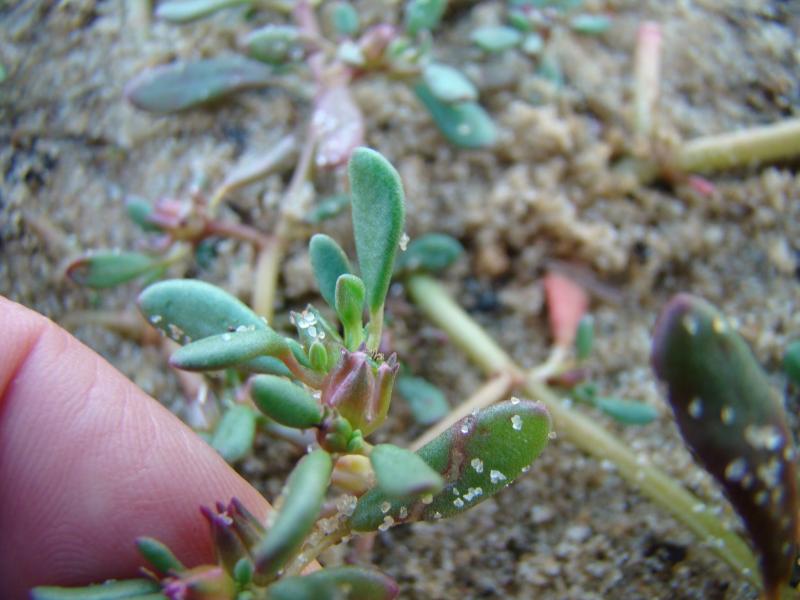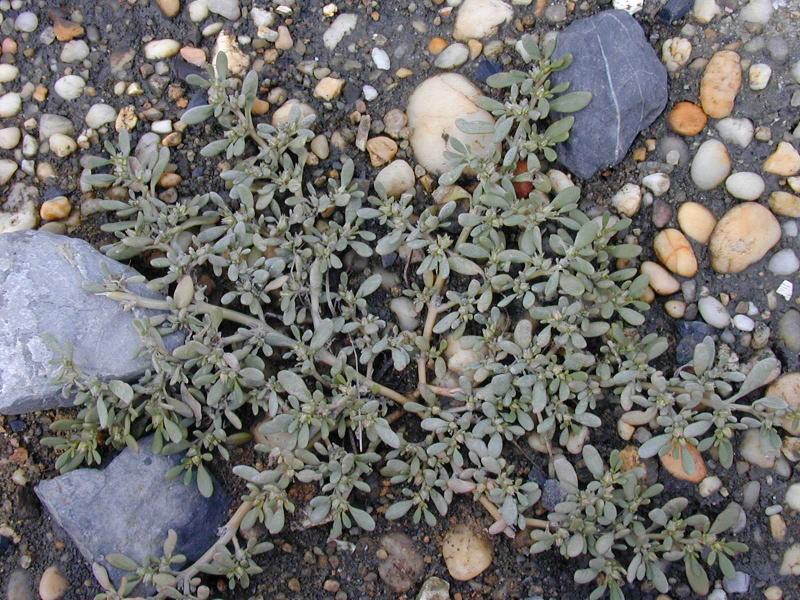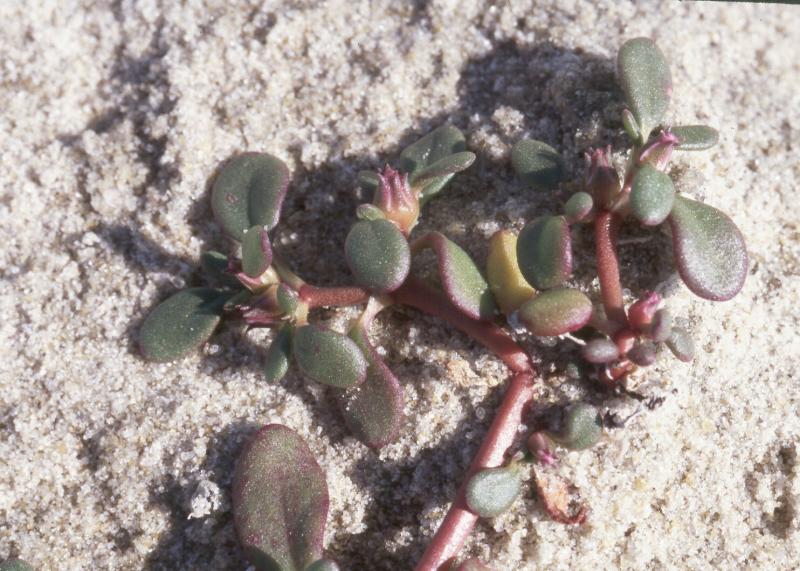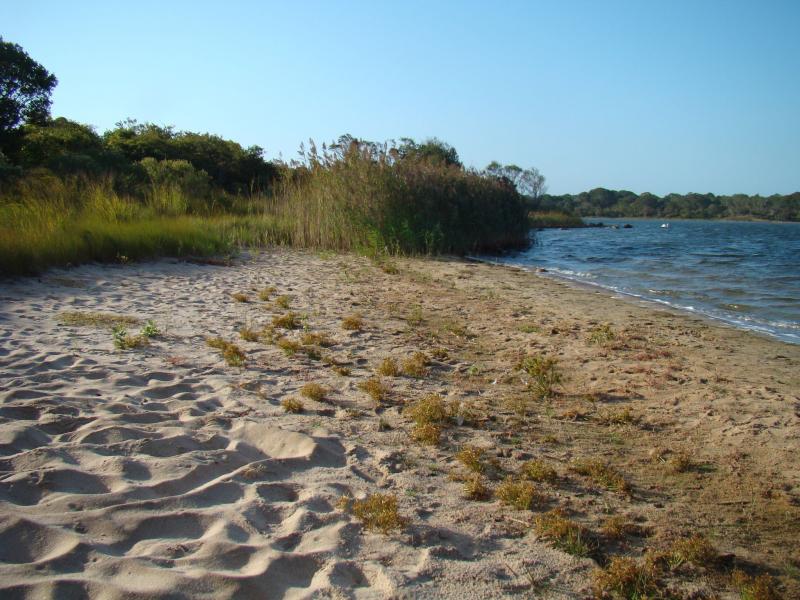Sea Purslane
Sesuvium maritimum (Walt.) B.S.P.
- Class
- Dicotyledoneae (Dicots)
- Family
- Aizoaceae (Fig-Marigold Family)
- State Protection
- Endangered
Listed as Endangered by New York State: in imminent danger of extirpation in New York. For animals, taking, importation, transportation, or possession is prohibited, except under license or permit. For plants, removal or damage without the consent of the landowner is prohibited.
- Federal Protection
- Not Listed
- State Conservation Status Rank
- S1
Critically Imperiled in New York - Especially vulnerable to disappearing from New York due to extreme rarity or other factors; typically 5 or fewer populations or locations in New York, very few individuals, very restricted range, very few remaining acres (or miles of stream), and/or very steep declines.
- Global Conservation Status Rank
- G5
Secure globally - Common in the world; widespread and abundant (but may be rare in some parts of its range).
Summary
Did you know?
The genus was named by Linnaeus after the Sesuvii, a Gallic tribe mentioned by Cesar as part of the Armoric states which, like Sesuvium, were located in the Atlantic maritime region in present-day France (McDevitte and Bohn 1869).
State Ranking Justification
There are three existing populations and two of them have over 100 plants each. The smaller population is in a pristine and well-protected area. There are also five historical records from the late 1800s to the mid-1940s which need to be resurveyed to see whether the plants are still there.
Short-term Trends
The short-term trend seems to be stable.
Long-term Trends
The long-term trend appears negative. This plant has always been very rare in New York but some of the older populations are probably not around anymore.
Conservation and Management
Threats
There are no known threats at this time.
Conservation Strategies and Management Practices
Natural area buffers should be maintained around the populations to prevent too much direct human disturbance.
Research Needs
Propagation studies could be done to see if populations can be augmented.
Habitat
Habitat
In New York, all the existing populations of Sesuvium maritimum occur on the shores of coastal salt ponds. These are sites where fresh water mixes with adjacent salt water. The ponds may be cut off from the ocean, but replenished during storms or high tide events. S. maritimum grows on the shores of such ponds in sandy or gravelly substrates, sometimes below the high tide line (New York Natural Heritage Program 2011). Sandy shores, beaches, dune swales, brackish marshes, banks along or near coasts, waste grounds, ballast (FNA 2003). Sea-beaches (Gleason and Cronquist 1991).
Associated Ecological Communities
- Coastal salt pond
(guide)
A community inhabiting marine shoreline lakes or ponds formed by sandspits that close off a lagoon or bay. The water typically averages brackish or slightly brackish over long periods of time, but may range rapidly from fresh to saline.
- Maritime beach
(guide)
A community with extremely sparse vegetation that occurs on unstable sand, gravel, or cobble ocean shores above mean high tide, where the shore is modified by storm waves and wind erosion.
Associated Species
- Phragmites australis (old world reed grass, old world phragmites)
- Polygonum glaucum (sea-beach knotweed)
- Salicornia depressa (slender glasswort)
- Salsola kali
- Sarcocornia pacifica
- Spergularia maritima
- Suaeda calceoliformis (horned sea-blite)
Range
New York State Distribution
This saltmarsh plant is only known from Suffolk County, Long Island. It is considered extirpated from the inland saltmarshes of the Syracuse area.
Global Distribution
This saltmarsh wildflower grows along the Atlantic and Gulf Coasts from New York south to Florida, west to Louisiana, to the coast of Texas. There are scattered inland populations north to Oklahoma and Kansas. It is rare along the Atlantic Coast from North Carolina north.
Identification Comments
General Description
Sea purslane is an annual, succulent herb, lying prostrate on the ground or ascending, and copiously branched. The leaves are opposite and entire, with up to 2.5 centimeters long, and tapering to the base, with clasping petioles. The flowers are solitary, with a pink to purplish calyx up to 3 millimeters long and 5 stamens. The fruit are ovoid capsules up to 5 millimeters long (FNA 2003).
Best Life Stage for Proper Identification
Sea Purslane may be identified in vegetative form as well as when flowering or fruiting.
Similar Species
There are no other species of Sesuvium in the northeast, and the fleshy, opposite leaves and prostrate, branching form give Sea purslane a unique appearance on New York's ocean beaches.
Best Time to See
Sesuvium maritimum flowers soon after it emerges in July, and the flowers and fruits may persist through September.
- Flowering
- Fruiting
The time of year you would expect to find Sea Purslane flowering and fruiting in New York.
Sea Purslane Images
Taxonomy
Sea Purslane
Sesuvium maritimum (Walt.) B.S.P.
- Kingdom Plantae
- Phylum Anthophyta
- Class Dicotyledoneae
(Dicots)
- Order Caryophyllales
- Family Aizoaceae (Fig-Marigold Family)
- Order Caryophyllales
- Class Dicotyledoneae
(Dicots)
- Phylum Anthophyta
Synonyms
- Pharnaceum maritimum Walter
- Sesuvium pentandrum Ell.
Additional Resources
Best Identification Reference
Flora of North America Editorial Committee. 2003. Flora of North America North of Mexico, Volume 4, Magnoliophyta: Caryophyllidae, Part 1. Oxford University Press, New York.
Other References
Fernald, M.L. 1950. Gray's manual of botany. 8th edition. D. Van Nostrand, New York. 1632 pp.
Gleason, Henry A. and A. Cronquist. 1991. Manual of Vascular Plants of Northeastern United States and Adjacent Canada. The New York Botanical Garden, Bronx, New York. 910 pp.
Holmgren, Noel. 1998. The Illustrated Companion to Gleason and Cronquist's Manual. Illustrations of the Vascular Plants of Northeastern United States and Adjacent Canada. The New York Botanical Garden, Bronx, New York.
Mitchell, Richard S. and Gordon C. Tucker. 1997. Revised Checklist of New York State Plants. Contributions to a Flora of New York State. Checklist IV. Bulletin No. 490. New York State Museum. Albany, NY. 400 pp.
New York Natural Heritage Program. 2010. Biotics database. New York Natural Heritage Program. New York State Department of Environmental Conservation. Albany, NY.
New York Natural Heritage Program. 2024. New York Natural Heritage Program Databases. Albany, NY.
Weldy, T. and D. Werier. 2010. New York flora atlas. [S.M. Landry, K.N. Campbell, and L.D. Mabe (original application development), Florida Center for Community Design and Research http://www.fccdr.usf.edu/. University of South Florida http://www.usf.edu/]. New York Flora Association http://newyork.plantatlas.usf.edu/, Albany, New York
Links
About This Guide
This guide was authored by: Richard M. Ring
Information for this guide was last updated on: September 6, 2012
Please cite this page as:
New York Natural Heritage Program. 2024.
Online Conservation Guide for
Sesuvium maritimum.
Available from: https://guides.nynhp.org/sea-purslane/.
Accessed July 26, 2024.



